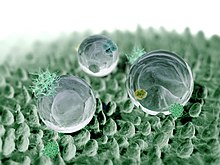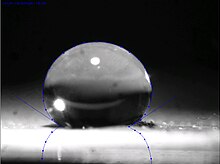



The lotus effect refers to self-cleaning properties that are a result of ultrahydrophobicity as exhibited by the leaves of Nelumbo, the lotus flower.[1] Dirt particles are picked up by water droplets due to the micro- and nanoscopic architecture on the surface, which minimizes the droplet's adhesion to that surface. Ultrahydrophobicity and self-cleaning properties are also found in other plants, such as Tropaeolum (nasturtium), Opuntia (prickly pear), Alchemilla, cane, and also on the wings of certain insects.[2]
The phenomenon of ultrahydrophobicity was first studied by Dettre and Johnson in 1964[3] using rough hydrophobic surfaces. Their work developed a theoretical model based on experiments with glass beads coated with paraffin or PTFE telomer. The self-cleaning property of ultrahydrophobic micro-nanostructured surfaces was studied by Wilhelm Barthlott and Ehler in 1977,[4] who described such self-cleaning and ultrahydrophobic properties for the first time as the "lotus effect"; perfluoroalkyl and perfluoropolyether ultrahydrophobic materials were developed by Brown in 1986 for handling chemical and biological fluids.[5] Other biotechnical applications have emerged since the 1990s.[6][7][8][9][10][11]
- ^ Lafuma, A.; Quere, D. (2003). "Superhydrophobic states". Nature Materials. 2 (7): 457–460. Bibcode:2003NatMa...2..457L. doi:10.1038/nmat924. PMID 12819775. S2CID 19652818.
- ^ Barthlott, W. (2023): “The Discovery of the Lotus Effect as a Key Innovation for Biomimetic Technologies” - in: Handbook of Self-Cleaning Surfaces and Materials: From Fundamentals to Applications, Chapter 15, pp. 359-369 - Wiley-VCH, https://doi.org/10.1002/9783527690688.ch15
- ^ Rulon E. JohnsonJr.; Robert H. Dettre (1964). "Contact Angle Hysteresis. III. Study of an Idealized Heterogeneous Surface". J. Phys. Chem. 68 (7): 1744–1750. doi:10.1021/j100789a012.
- ^ Barthlott, Wilhelm; Ehler, N. (1977). "Raster-Elektronenmikroskopie der Epidermis-Oberflächen von Spermatophyten". Tropische und Subtropische Pflanzenwelt. 19: 110.
- ^ Brown Laboratory vessel having hydrophobic coating and process for manufacturing same Archived 2017-01-22 at the Wayback Machine U.S. patent 5,853,894, Issued December 29, 1998
- ^ Barthlott, Wilhelm; C. Neinhuis (1997). "The purity of sacred lotus or escape from contamination in biological surfaces". Planta. 202: 1–8. doi:10.1007/s004250050096. S2CID 37872229.
- ^ Barthlott, W., Mail, M., Bhushan, B., & K. Koch. (2017). Plant Surfaces: Structures and Functions for Biomimetic Innovations. Nano-Micro Letters, 9(23), doi:10.1007/s40820-016-0125-1.
- ^ Cheng, Y. T.; Rodak, D. E. (2005). "Is the lotus leaf superhydrophobic?". Appl. Phys. Lett. 86 (14): 144101. Bibcode:2005ApPhL..86n4101C. doi:10.1063/1.1895487.
- ^ Narhe, R. D.; Beysens, D. A. (2006). "Water condensation on a super-hydrophobic spike surface". Europhys. Lett. 75 (1): 98–104. Bibcode:2006EL.....75...98N. doi:10.1209/epl/i2006-10069-9.
- ^ Lai, S.C.S. "Mimicking nature: Physical basis and artificial synthesis of the Lotus effect" (PDF). Archived from the original (PDF) on 2007-09-30.
- ^ Koch, K.; Bhushan, B.; Barthlott, W. (2008). "Diversity of structure, Morphology and Wetting of Plant Surfaces. Soft matter". Soft Matter. 4 (10): 1943. Bibcode:2008SMat....4.1943K. doi:10.1039/b804854a.